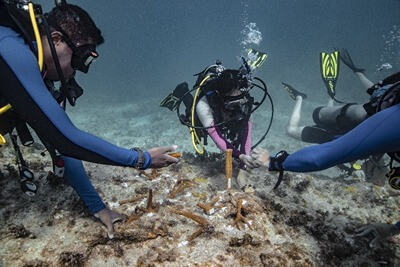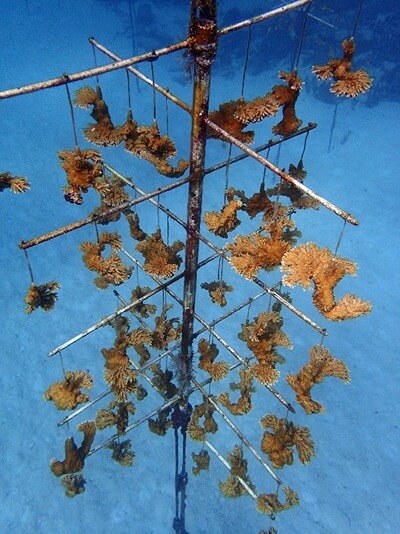Coral Reef Restoration

Conservation Issue
Coral reefs in Florida have experienced catastrophic losses of living coral over the last four decades, and these ecosystems continue to be vulnerable to further decline due to threats associated with ocean warming and acidification, bleaching and disease, hurricanes, degraded water quality, and a suite of localized human impacts. Coral reef restoration is one tool to rebuild degraded reefs, but new technologies and approaches are needed to increase the scale of restoration and improve long- term outcomes and benefits.
Description
In response to rapid declines in the condition of coral reefs, state and federal agencies are implementing new zoning, regulatory and management measures designed to abate human pressures while concurrently working closely with local partners to rehabilitate degraded reefs. One of the most promising efforts that has expanded over the last 15 years involves propagating and outplanting nursery-reared corals, with small-scale outplanting efforts completed on over 100 reefs in the Florida Keys. While survival of these outplants has continued to improve, it has, until recently, involved a small number of coral species (primarily staghorn coral), relatively low outplant numbers, and minimal overall ecosystem benefits.
Since 2020, restoration practitioners have been refining propagation and outplanting approaches, testing new techniques and species, and expanding work at selected locations, including an emphasis on seven iconic reefs as part of the Mission: Iconic Reefs program. Restoration projects are also being designed to answer specific questions (e.g., ways to minimize predation pressure, disease, and competition), identify best practices for the propagation and outplanting of new species and more resilient genotypes, and approaches that integrate ecological processes (e.g., restoring herbivory, stabilizing substrates with sponges) to maximize survivorship of corals and enhance reef resilience.
Recognizing the challenges in building resilience to changing ocean conditions and continued pressures reefs face, the main goals of coral reef restoration efforts in Florida are to recover key ecosystem processes, functions, and services, and enhance reef resilience. The success of this approach requires: 1) better integration of keystone reef organisms and ecological processes; 2) coral predator control strategies; 3) considerations of connectivity among reefs and associated fish nursery habitats (e.g., seagrasses and mangroves); 4) creation of positive feedback loops to facilitate recovery by improving recruitment habitat and minimizing nuisance species; 5) improvement in the health, growth, and survival of nursery-propagated corals and sexual recruits; and 6) a genetic population management strategy that ensures adequate genotypic diversity at outplant sites, inclusion of genotypes that are resistant/resilient to stressors, and creation of gene banks to preserve the genetic diversity. In addition to the development of new tools and technologies, successful restoration relies on our ability to engage stakeholders, empower partnerships, and link conservation goals to economic goals. Coral reef restoration is an essential component of a comprehensive strategy to improve the health of Florida’s Coral Reef and preserve it for future generations.

Data and Analysis Needs
- Strategies for enhancing settlement, growth, and survival of sexual recruits and outplants
- Strategies for maximizing resilience to disease, bleaching, poor water quality, and other stressors through selective propagation of certain resistant genotypes, stress hardening corals before outplanting, selective breeding, and/or symbiont manipulations
- Identification of reefs and/or microhabitats likely to exhibit higher rates of natural settlement of larvae and survival of settled sexual recruits and asexual fragments
- Novel techniques to enhance growth and survival of corals in nurseries and increase scale of outplanting of these corals
- Optimal approaches for reintroduction of herbivorous urchins and crabs, including relocations, larval collections and captive bred organisms, optimal density, habitat requirements, etc.
- More environmentally friendly methods to attach corals that reduce the use of plastic, iron nails, epoxy, and cement, including optimal substrate types/modules to attach microfragments for reskinning and grow-out of boulder corals
- Effectiveness of restoration for mitigating storm impacts and additional steps that can be taken to maximize ecosystem services such as coastal protection via restoration efforts
- Optimal outplant designs and habitat attributes to maximize coral survival, improve structural complexity of sites, and restore ecosystem function
Potential Products
- Structure from motion (SfM) photomosaics, videos, and story maps to track restoration progress
- Best practices manuals (outplanting, nursery propagation, monitoring, genetic management)
- One-pagers for each reef targeted in the Mission: Iconic Reefs program
- Genetic tracking database for corals
- Blue Star operator and citizen scientist programs and outreach
- Identification guides for monitoring, preparation, and maintenance of outplant sites
- Streamlined permitting processes
For more information about this assessment, contact Andy.Bruckner@noaa.gov.

